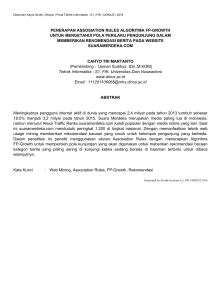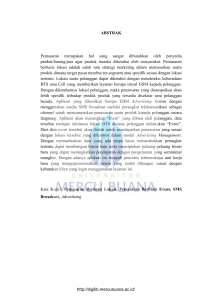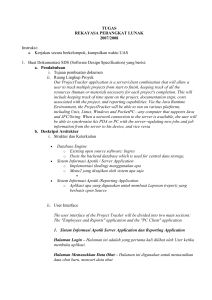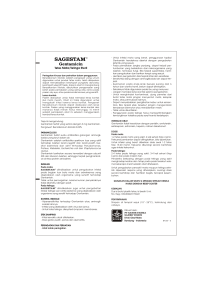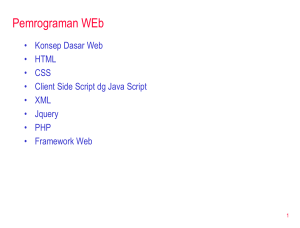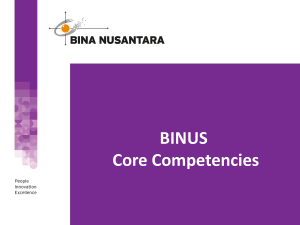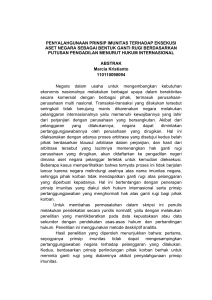interrupt - Direktori File UPI
advertisement
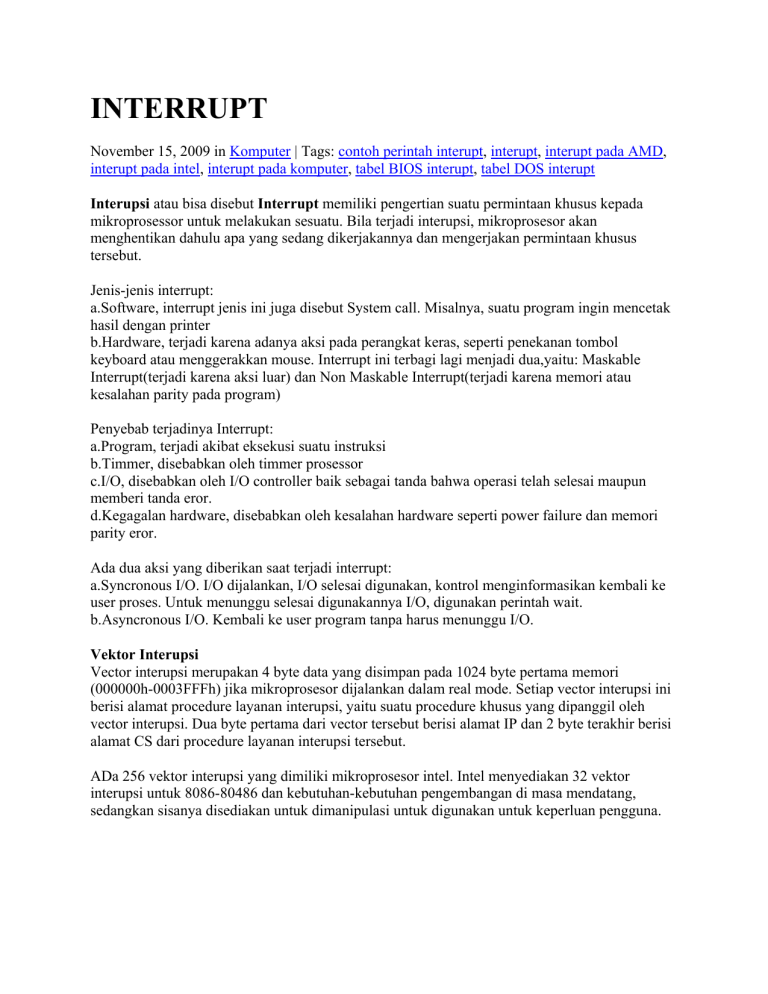
INTERRUPT
November 15, 2009 in Komputer | Tags: contoh perintah interupt, interupt, interupt pada AMD,
interupt pada intel, interupt pada komputer, tabel BIOS interupt, tabel DOS interupt
Interupsi atau bisa disebut Interrupt memiliki pengertian suatu permintaan khusus kepada
mikroprosessor untuk melakukan sesuatu. Bila terjadi interupsi, mikroprosesor akan
menghentikan dahulu apa yang sedang dikerjakannya dan mengerjakan permintaan khusus
tersebut.
Jenis-jenis interrupt:
a.Software, interrupt jenis ini juga disebut System call. Misalnya, suatu program ingin mencetak
hasil dengan printer
b.Hardware, terjadi karena adanya aksi pada perangkat keras, seperti penekanan tombol
keyboard atau menggerakkan mouse. Interrupt ini terbagi lagi menjadi dua,yaitu: Maskable
Interrupt(terjadi karena aksi luar) dan Non Maskable Interrupt(terjadi karena memori atau
kesalahan parity pada program)
Penyebab terjadinya Interrupt:
a.Program, terjadi akibat eksekusi suatu instruksi
b.Timmer, disebabkan oleh timmer prosessor
c.I/O, disebabkan oleh I/O controller baik sebagai tanda bahwa operasi telah selesai maupun
memberi tanda eror.
d.Kegagalan hardware, disebabkan oleh kesalahan hardware seperti power failure dan memori
parity eror.
Ada dua aksi yang diberikan saat terjadi interrupt:
a.Syncronous I/O. I/O dijalankan, I/O selesai digunakan, kontrol menginformasikan kembali ke
user proses. Untuk menunggu selesai digunakannya I/O, digunakan perintah wait.
b.Asyncronous I/O. Kembali ke user program tanpa harus menunggu I/O.
Vektor Interupsi
Vector interupsi merupakan 4 byte data yang disimpan pada 1024 byte pertama memori
(000000h-0003FFFh) jika mikroprosesor dijalankan dalam real mode. Setiap vector interupsi ini
berisi alamat procedure layanan interupsi, yaitu suatu procedure khusus yang dipanggil oleh
vector interupsi. Dua byte pertama dari vector tersebut berisi alamat IP dan 2 byte terakhir berisi
alamat CS dari procedure layanan interupsi tersebut.
ADa 256 vektor interupsi yang dimiliki mikroprosesor intel. Intel menyediakan 32 vektor
interupsi untuk 8086-80486 dan kebutuhan-kebutuhan pengembangan di masa mendatang,
sedangkan sisanya disediakan untuk dimanipulasi untuk digunakan untuk keperluan pengguna.
Berikut ini adalah table vector interupsi pada mikroprosesor keluarga intel:
Keterangan:
a.* = dicadangkan untuk pengembangan di masa mendatang
b.Vektor no. 1-7,9,16, dan 17 dapat digunakan untuk pemrograman real mode dan protected
mode, sedangkan yang lain hanya untuk protected mode.
c.INT 100 berarti memanggil procedure layanan nomor 100 yang alamatnya pada 190h-193h.
Instruksi Interrupt pada PC (Personal Computer)
Instruksi interrupt pada PC(personal computer) berbeda dengan interupsi pada table interupai
diatas, sebab PC pada awalnya dikembangkan berbasis (compatible dengan) system 8086-8088.
Jadi interupsi yang sama di setiap PC adalah interupsi no 0-4. Berikut ini adalah table interupsi
yang terdapat pada PC:
Ada interupsi yang hanya trdiri dari 1 fungi layanan,misalnya INT20h (untuk menghentikan
program), tetapi ada pula yang lebih, misalnya INT 21h, INT10h, dll. Untuk memanggil nomor
layanan tertentu, nomor layanan tersebut harus dimasukkan dulu ke register AH sebelum INT
bersangkutan dieksekusi.
sumber : http://rani-amalia-elins1.blogspot.com/
Interrupt
From Wikipedia, the free encyclopedia
Jump to: navigation, search
Operating systems
Common features
Process management
Interrupts
Memory management
Virtual file system
Device drivers
Networking
Security
Graphical user interfaces
v•d•e
In computing, an interrupt is an asynchronous signal indicating the need for attention or a
synchronous event in software indicating the need for a change in execution.
A hardware interrupt causes the processor to save its state of execution and begin execution of
an interrupt handler.
Software interrupts are usually implemented as instructions in the instruction set, which cause a
context switch to an interrupt handler similar to a hardware interrupt.
Interrupts are a commonly used technique for computer multitasking, especially in real-time
computing. Such a system is said to be interrupt-driven.[1]
An act of interrupting is referred to as an interrupt request (IRQ).
Contents
1 Overview
2 Types of Interrupts
o 2.1 Level-triggered
o 2.2 Edge-triggered
o 2.3 Hybrid
o 2.4 Message-signalled
o 2.5 Doorbell
3 Difficulty with sharing interrupt lines
4 Performance issues
5 Typical uses
o 5.1 Interrupt routine example
6 See also
7 References
8 External links
Overview
Hardware interrupts were introduced as a way to avoid wasting the processor's valuable time in
polling loops, waiting for external events. They may be implemented in hardware as a distinct
system with control lines, or they may be integrated into the memory subsystem.
If implemented in hardware, an interrupt controller circuit such as the IBM PC's Programmable
Interrupt Controller (PIC) may be connected between the interrupting device and the processor's
interrupt pin to multiplex several sources of interrupt onto the one or two CPU lines typically
available. If implemented as part of the memory controller, interrupts are mapped into the
system's memory address space.
Interrupts can be categorized into: maskable interrupt, non-maskable interrupt (NMI),
interprocessor interrupt (IPI), software interrupt, and spurious interrupt.
Maskable interrupt (IRQ) is a hardware interrupt that may be ignored by setting a bit in an
interrupt mask register's (IMR) bit-mask.
Non-maskable interrupt (NMI) is a hardware interrupt that lacks an associated bit-mask, so that
it can never be ignored. NMIs are often used for timers, especially watchdog timers.
Interprocessor interrupt is a special case of interrupt that is generated by one processor to
interrupt another processor in a multiprocessor system.
Software interrupt is an interrupt generated within a processor by executing an instruction.
Software interrupts are often used to implement system calls because they implement a
subroutine call with a CPU ring level change.
Spurious interrupt is a hardware interrupt that is unwanted. They are typically generated by
system conditions such as electrical interference on an interrupt line or through incorrectly
designed hardware.
Processors typically have an internal interrupt mask which allows software to ignore all external
hardware interrupts while it is set. This mask may offer faster access than accessing an interrupt
mask register (IMR) in a PIC, or disabling interrupts in the device itself. In some cases, such as
the x86 architecture, disabling and enabling interrupts on the processor itself act as a memory
barrier, however it may actually be slower.
An interrupt that leaves the machine in a well-defined state is called a precise interrupt. Such
an interrupt has four properties:
The Program Counter (PC) is saved in a known place.
All instructions before the one pointed to by the PC have fully executed.
No instruction beyond the one pointed to by the PC has been executed (that is no prohibition on
instruction beyond that in PC, it is just that any changes they make to registers or memory must
be undone before the interrupt happens).
The execution state of the instruction pointed to by the PC is known.
An interrupt that does not meet these requirements is called an imprecise interrupt.
The phenomenon where the overall system performance is severely hindered by excessive
amounts of processing time spent handling interrupts is called an interrupt storm.
Types of Interrupts
Level-triggered
A level-triggered interrupt is a class of interrupts where the presence of an unserviced interrupt
is indicated by a high level (1), or low level (0), of the interrupt request line. A device wishing to
signal an interrupt drives line to its active level, and then holds it at that level until serviced. It
ceases asserting the line when the CPU commands it to or otherwise handles the condition that
caused it to signal the interrupt.
Typically, the processor samples the interrupt input at predefined times during each bus cycle
such as state T2 for the Z80 microprocessor. If the interrupt isn't active when the processor
samples it, the CPU doesn't see it. One possible use for this type of interrupt is to minimize
spurious signals from a noisy interrupt line: a spurious pulse will often be so short that it is not
noticed.
Multiple devices may share a level-triggered interrupt line if they are designed to. The interrupt
line must have a pull-down or pull-up resistor so that when not actively driven it settles to its
inactive state. Devices actively assert the line to indicate an outstanding interrupt, but let the line
float (do not actively drive it) when not signalling an interrupt. The line is then in its asserted
state when any (one or more than one) of the sharing devices is signalling an outstanding
interrupt.
This class of interrupts is favored by some because of a convenient behavior when the line is
shared. Upon detecting assertion of the interrupt line, the CPU must search through the devices
sharing it until one requiring service is detected. After servicing this device, the CPU may
recheck the interrupt line status to determine whether any other devices also need service. If the
line is now de-asserted, the CPU avoids checking the remaining devices on the line. Since some
devices interrupt more frequently than others, and other device interrupts are particularly
expensive, a careful ordering of device checks is employed to increase efficiency.
There are also serious problems with sharing level-triggered interrupts. As long as any device on
the line has an outstanding request for service the line remains asserted, so it is not possible to
detect a change in the status of any other device. Deferring servicing a low-priority device is not
an option, because this would prevent detection of service requests from higher-priority devices.
If there is a device on the line that the CPU does not know how to service, then any interrupt
from that device permanently blocks all interrupts from the other devices.
The original PCI standard mandated shareable level-triggered interrupts. The rationale for this
was the efficiency gain discussed above. (Newer versions of PCI allow, and PCI Express
requires the use of message-signalled interrupts.)
Edge-triggered
An edge-triggered interrupt is a class of interrupts that are signalled by a level transition on the
interrupt line, either a falling edge (1 to 0) or a rising edge (0 to 1). A device wishing to signal an
interrupt drives a pulse onto the line and then releases the line to its quiescent state. If the pulse is
too short to be detected by polled I/O then special hardware may be required to detect the edge.
Multiple devices may share an edge-triggered interrupt line if they are designed to. The interrupt
line must have a pull-down or pull-up resistor so that when not actively driven it settles to one
particular state. Devices signal an interrupt by briefly driving the line to its non-default state, and
let the line float (do not actively drive it) when not signalling an interrupt. This type of
connection is also referred to as open collector. The line then carries all the pulses generated by
all the devices. (This is analogous to the pull cord on some buses and trolleys that any passenger
can pull to signal the driver that they are requesting a stop.) However, interrupt pulses from
different devices may merge if they occur close in time. To avoid losing interrupts the CPU must
trigger on the trailing edge of the pulse (e.g. the rising edge if the line is pulled up and driven
low). After detecting an interrupt the CPU must check all the devices for service requirements.
Edge-triggered interrupts do not suffer the problems that level-triggered interrupts have with
sharing. Service of a low-priority device can be postponed arbitrarily, and interrupts will
continue to be received from the high-priority devices that are being serviced. If there is a device
that the CPU does not know how to service, it may cause a spurious interrupt, or even periodic
spurious interrupts, but it does not interfere with the interrupt signalling of the other devices.
However, it is fairly easy for an edge triggered interrupt to be missed - for example if interrupts
have to be masked for a period - and unless there is some type of hardware latch that records the
event it is impossible to recover. Such problems caused many "lockups" in early computer
hardware because the processor did not know it was expected to do something. More modern
hardware often has one or more interrupt status registers that latch the interrupt requests; well
written edge-driven interrupt software often checks such registers to ensure events are not
missed.
The elderly Industry Standard Architecture (ISA) bus uses edge-triggered interrupts, but does not
mandate that devices be able to share them. The parallel port also uses edge-triggered interrupts.
Many older devices assume that they have exclusive use of their interrupt line, making it
electrically unsafe to share them. However, ISA motherboards include pull-up resistors on the
IRQ lines, so well-behaved devices share ISA interrupts just fine.
Hybrid
Some systems use a hybrid of level-triggered and edge-triggered signalling. The hardware not
only looks for an edge, but it also verifies that the interrupt signal stays active for a certain period
of time.
A common use of a hybrid interrupt is for the NMI (non-maskable interrupt) input. Because
NMIs generally signal major – or even catastrophic – system events, a good implementation of
this signal tries to ensure that the interrupt is valid by verifying that it remains active for a period
of time. This 2-step approach helps to eliminate false interrupts from affecting the system.
Message-signalled
Main article: Message Signaled Interrupts
A message-signalled interrupt does not use a physical interrupt line. Instead, a device signals
its request for service by sending a short message over some communications medium, typically
a computer bus. The message might be of a type reserved for interrupts, or it might be of some
pre-existing type such as a memory write.
Message-signalled interrupts behave very much like edge-triggered interrupts, in that the
interrupt is a momentary signal rather than a continuous condition. Interrupt-handling software
treats the two in much the same manner. Typically, multiple pending message-signalled
interrupts with the same message (the same virtual interrupt line) are allowed to merge, just as
closely-spaced edge-triggered interrupts can merge.
Message-signalled interrupt vectors can be shared, to the extent that the underlying
communication medium can be shared. No additional effort is required.
Because the identity of the interrupt is indicated by a pattern of data bits, not requiring a separate
physical conductor, many more distinct interrupts can be efficiently handled. This reduces the
need for sharing. Interrupt messages can also be passed over a serial bus, not requiring any
additional lines.
PCI Express, a serial computer bus, uses message-signalled interrupts exclusively.
Doorbell
In a push button analogy applied to computer systems, the term doorbell or doorbell interrupt
is often used to describe a mechanism whereby a software system can signal or notify a hardware
device that there is some work to be done. Typically, the software system will place data in some
well known and mutually agreed upon memory location(s), and "ring the doorbell" by writing to
a different memory location. This different memory location is often called the doorbell region,
and there may even be multiple doorbells serving different purposes in this region. It's this act of
writing to the doorbell region of memory that "rings the bell" and notifies the hardware device
that the data is ready and waiting. The hardware device would now know that the data is valid
and can be acted upon. It would typically write the data to a hard disk drive, or send it over a
network, or encrypt it, etc.
The term doorbell interrupt is usually a misnomer. It's similar to an interrupt because it causes
some work to be done by the device, however the doorbell region is sometimes implemented as a
polled region, sometimes the doorbell region writes through to physical device registers, and
sometimes the doorbell region is hardwired directly to physical device registers. When either
writing through or directly to physical device registers, this may, but not necessarily, cause a real
interrupt to occur at the device's central processor unit (CPU), if it has one.
Doorbell interrupts can be compared to Message Signaled Interrupts, as they have some
similarities.
Difficulty with sharing interrupt lines
Multiple devices sharing an interrupt line (of any triggering style) all act as spurious interrupt
sources with respect to each other. With many devices on one line the workload in servicing
interrupts grows in proportion to the square of the number of devices. It is therefore preferred to
spread devices evenly across the available interrupt lines. Shortage of interrupt lines is a problem
in older system designs where the interrupt lines are distinct physical conductors. Messagesignalled interrupts, where the interrupt line is virtual, are favoured in new system architectures
(such as PCI Express) and relieve this problem to a considerable extent.
Some devices with a badly-designed programming interface provide no way to determine
whether they have requested service. They may lock up or otherwise misbehave if serviced when
they do not want it. Such devices cannot tolerate spurious interrupts, and so also cannot tolerate
sharing an interrupt line. ISA cards, due to often cheap design and construction, are notorious for
this problem. Such devices are becoming much rarer, as hardware logic becomes cheaper and
new system architectures mandate shareable interrupts.
Performance issues
Interrupts provide low overhead and good latency at low offered load, but degrade significantly
at high interrupt rate unless care is taken to prevent several pathologies. These are various forms
of livelocks, when the system spends all of its time processing interrupts, to the exclusion of
other required tasks. Under extreme conditions, a large number of interrupts (like very high
network traffic) may completely stall the system. To avoid such problems, an operating system
must schedule network interrupt handling as carefully as it schedules process execution.[2]
Typical uses
Typical uses of interrupts include the following: system timers, disks I/O, power-off signals, and
traps. Other interrupts exist to transfer data bytes using UARTs or Ethernet; sense key-presses;
control motors; or anything else the equipment must do.
A classic system timer interrupt interrupts periodically from a counter or the power-line. The
interrupt handler counts the interrupts to keep time. The timer interrupt may also be used by the
OS's task scheduler to reschedule the priorities of running processes. Counters are popular, but
some older computers used the power line frequency instead, because power companies in most
Western countries control the power-line frequency with a very accurate atomic clock.
A disk interrupt signals the completion of a data transfer from or to the disk peripheral. A
process waiting to read or write a file starts up again.
A power-off interrupt predicts or requests a loss of power. It allows the computer equipment to
perform an orderly shutdown.
Interrupts are also used in typeahead features for buffering events like keystrokes.
[edit] Interrupt routine example
Microchip PIC 18Fxxxx Microcontroller, compiled under MPLAB C18 compiler. The routine
displays the number of interrupts occurred on port A, while it keeps toggling LEDs on port D:
//**************************************************************
/*
* Name : Interrupt.c
*
* Compiler : C18
*
* PIC : 18F Familly
*
* AUTHOR : BENKORICH Abdellah
*
* University : Boumerdes, ALGERIA
*/
//*************************************************************/
#include <p18f4550.h> /* for the special function register declarations ,
you may include yours here */
#include <portb.h> /* for the RB0/INT0 interrupt */
/* Set configuration bits for use with ICD2 / PICDEM2 PLUS Demo Board:
* - set HS oscillator
* - disable watchdog timer
* - disable low voltage programming
* - enable background debugging
*/
#pragma
#pragma
#pragma
#define
config WDT = OFF
config LVP = OFF
config DEBUG = ON
FOSC 40e6
void delay(long time) ;
int state=1; //The state of A0.
/*
* For high interrupts, control is transferred to address 0x8.
*/
void update_cnt (void); /* prototype needed for 'goto' below */
#pragma code HIGH_INTERRUPT_VECTOR = 0x8
void high_ISR (void)
{
_asm
goto update_cnt
_endasm
}
#pragma code /* allow the linker to locate the remaining code */
#pragma interrupt update_cnt
void update_cnt (void)
{
PORTA =state;
state ++ ;
INTCONbits.INT0IF = 0; /* clear flag to avoid another interrupt */
}
void EnableHighInterrupts (void)
{
RCONbits.IPEN = 1; /* enable interrupt priority levels */
INTCONbits.GIEH = 1; /* enable all high priority interrupts */
}
// delay Function
void delay (long time){
long i;
for (i=0; i<time; i++){
}
}
// main function
void main (void)
{
TRISA = 0x00; //Set port A as output
LATA=0; //Initialize Port A.
ADCON1 = 0b00001111; //All ADC disabled
TRISD = 0x00; //Set port D as output
LATD=0; //Initialize Port D.
EnableHighInterrupts ( );
OpenRB0INT (PORTB_CHANGE_INT_ON & /* enable the RB0/INT0 interrupt */
PORTB_PULLUPS_ON &
FALLING_EDGE_INT);
/* configure the RB0 pin for input */
/* trigger interrupt upon S3 button
depression */
while (1) {
PORTD = 0x00;
delay(FOSC/5000);
PORTD = 0xFF;
delay(FOSC/5000);
}
}
Penjabaran
Arti istilah interrupt dianggap berkaitan erat dengan pengertian berikut
Kejadian-kejadian sinkron yang merupakan tanggapan pemroses terhadap kondisi-kondisi tertentu
yang memerlukan perhatian. Sebuah setting hardware yang menjalankan perintah-perintah dalam
sistem komputer.
Interrupt secara harfiah dalam bahasa Indonesianya diartikan sebagai selaan, menyela, atau menjegal,
atau istilah kerennya disebut dengan interupsi.
Interrupt bisa diibaratkan dalam kehidupan sehari-hari sebagai suatu proses berjalan, namun belum
selesai proses tersebut melakukan tugasnya, sudah dilaksanakan lagi proses lainnya.
Ibaratnya begini, ketika anda sedang melakukan suatu pekerjaan, katakanlah membaca sebuah buku,
belum selesai buku tersebut anda tamatkan, lalu telepon anda berbunyi, sehingga anda melakukan
percakapan terlebih dahulu melalui telepon tersebut. Setelah pembicaraan selesai, anda melanjutkan
membaca buku tadi. menerima telepon di dalam kejadian tersebut disebut dengan menyela.
Begitu juga dengan proses yang terjadi pada komputer. Apabila sebuah komputer melakukan
prosesnya tanda ada gangguan, tentu komputer tersebut dapat menyelesaikan pekerjaannya dengan
serius khusus untuk satu pekerjaan yang sedang dikerjakannya. Dalam kondisi demikian, komputer
anda melakukan tugasnya yang disebut dengan primitive batch processing. Pekerjaan seperti ini
digunakan oleh komputer pada komputer zaman awal-awal ditemukannya. Dimana komputer tidak
bisa mengerjakan beberapa program sekaligus dalam waktu bersamaan, sampai satu pekerjaan selesai
dikerjakan, maka baru dia bisa berpindah ke pekerjaan lainnya.
Komputer terkini, memiliki kemampuan interrupt ini. Penulis melakukan pengetikkan naskah ini
sambil mendengarkan musik yang terpasang pada notebook yang digunakan, tidak jarang komputer
ini juga sambil terhubung dengan internet untuk membuka halaman web atau mengambil beberapa
data yang ada di internet.
Anda tentu juga tidak jarang mengalami hal dengan interrupt ini, katakanlah, ketika mengetikkan SMS
ternyata ada telpon yang masuk, anda terima dulu telpon tersebut, lalu setelahnya anda lanjutkan
pengetikan SMS tadi.
Untuk memungkinkan terjadinya interrupt ini pada sistem komputer, CPU memiliki suatu jalur khusus
terhadap suatu chip pengatur interrupt eksternal (bagian dari chipset), yang berisi database
sederhana yang dikenal dengan interrupt vectors.
Ketika sebuah interrupt terjadi pada chip, maka CPU menyimpan informasi terakhir yang dia kerjakan,
berulah dia mengerjakan sesuai dengan informasi yang ada pada interrupt vector tesebut. Interrupt
vector ini sebenarnya hanya sebuah nama pemanis yang berisi informasi tentang selaan yang terjadi,
kalau dibelah lebih dalam lagi, isinya adalah berupa tabel yang berisi angka-angka). Pada interrupt
vector inilah ditemukan kemana dan apa proses berikutnya yang harus dilaksanakan oleh komputer.
Ketika pekerjaan interrupt tadi selesai dilaksanakan, maka komputer melakukan pelacakan kembali
apa pekerjaan sebelumnya yang sedang dilaksanakannya.
Prioritas dalam interrupt
Dalam penerimaan suatu interrupt ini, komputer membagi interrupt tersebut dalam berbagai level,
tergantung dari CPU yang digunakan. Misalnya pada komputer yang digunakan untuk pekerjaan yang
cukup membutuhkan konsentrasi dari CPU, maka CPU tersebut memungkinkan untuk mengabaikan
interrupt yang prioritasnya rendah, katakanlah pengetikkan yang dilakukan oleh seorang user melalui
keyboard, namun komputer tersebut akan memberikan respon yang sangat cepat apabila terjadi
gangguan pada memori yang digunakannya.
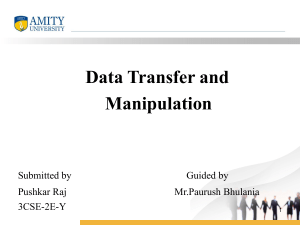
![SO11 [Compatibility Mode]](http://s1.studylibid.com/store/data/001005096_1-f3c69f10aa0f82c2dc2958a2ee9416e5-300x300.png)
